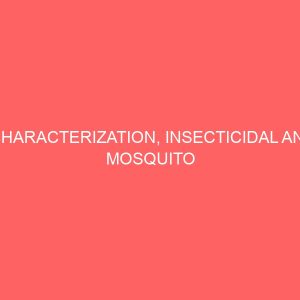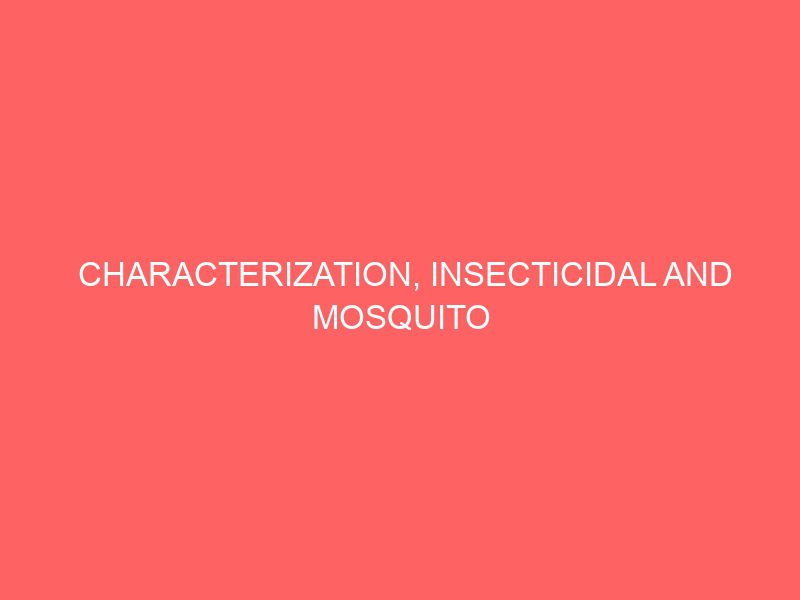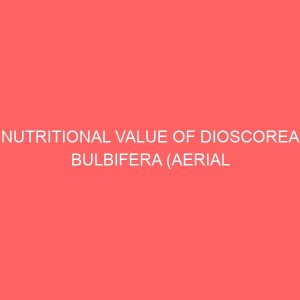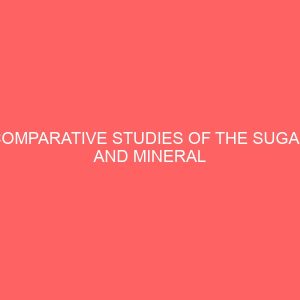Description
CHAPTER ONE
- INTRODUCTION
1.1 Background to the study
This project is on Characterization, insecticidal and mosquito repellency properties of essential oils from hyptis suaveolens leaves. Plants have always served as food and medicine to man since the beginning of life. Their nutritional and medicinal potentials have been attributed to the phytochemicals and other chemical constituents contained in them. Despite their importance, it has been reported that out of the 250,000 to 500,000 species of existing plants on earth, only about 300 species are utilized in the food, pharmaceutical, cosmetics and perfume industries. Traditionally used medicinal plants produce a variety of compounds of known therapeutic properties (Umedum et al., 2014).
Medicinal plants are used in traditional treatments to cure variety of diseases. In the last few decades there has been an exponential growth in the field of herbal medicine. Natural products have been a source of drugs for centuries (Dinet al., 2011). Traditional medicines (plants source) has been used for thousands of years for the treatment of malaria and are the source of two main groups (artemisinin and quinine derivatives) of modern antimalarial drugs (Kazembe et al., 2012).
Repellents are substances applied to the skin, which prevent insects from biting such surface (Traoré-Coulibalyet al., 2013).An insect repellent is a substance that causes an organism to move away from the odour source, insects perceive the volatile repellents by smell (Luts et al., 2014).
Essential oils are volatile natural complex secondary metabolites characterized by a strong odour and have a generally lower density than that of water (Arun et al., 2009). They are natural volatile mixtures of hydrocarbons with a diversity of functional groups, and their repellent activity has been linked to the presence of monoterpenes and sesquiterpenes (Moreiraet al., 2010;Chaubey 2012; Traoré-Coulibalyet al., 2013). Essential oils are plant products obtained by hydro-distillation or other methods (Luts et al., 2014). This complex of compounds are produced by plants, giving them their characteristic smell and taste, and are usually composed of 20–80 or more substances. Their main components are monoterpenes (C10) and sesquiterpenes (C15) derived from isoprene (Luts et al., 2014).Several monoterpenes have been reported as insect repellents (Luts et al., 2014).There are 17,500 aromatic plant species among higher plants and approximately 3,000 essential oils are known out of which300 are commercially important for pharmaceuticals, cosmetics and perfume industries. Apart from insecticidal potential they are lipophilic in nature and interfere with basic metabolic, biochemical, physiological and behavioural functions of insects. They are also used as flavour in food products, odorants in flagrances, pharmaceuticals (antimicrobial) and as insecticides(Moreiraet al., 2010).
Hyptis suaveolens (L.Poit) is one of the important traditional medicinal plants belonging to family lamiaceae (Umedum et al., 2014). It is commonly called Bush mint, Bush tea, Pignut, or Chan. It is known generally as Vilayati Tulsi in Hindi, Konda Thulasi in Telugu, Bhustrena in Sanskrit, Daddoya-ta-daji ( family name) and specifically Sarakuwan sauro in Hausa, Efiri (family name) in Yoruba, Nchuanwu (family name) in Ibo, and Tanmotswangi-eba in Nupe (Umedum et al., 2014; Ghafari et al., 2014).
Leaves of Hyptis suaveolens have been traditionally used as a stimulant, antisplasmoidic, against colds and diarrhoea (Shaikat et al., 2012). It has been and still in use traditionally to repel mosquitoes by burning the leaves (Singh et al., 2011; Vongsombothet al., 2012).
The repellent activity of the whole Hyptis suaveolens essential oil and single major constituents against adults of S. granarius has been evaluated (Benelli et al., 2012). Amongst the several methods available to evaluate the repellence of natural products, the filter paper tests in Petri dish is one of the most commonly used bioassays (Benelli et al., 2012). Several authors reported a large variability in the composition of this family due to genetic, geographical and seasonal factors. Since the biological activities of essential oils are composition-dependent, it is apparent that it is very important to fully characterize these mixtures from the chemical point of view (Benelli et al., 2012).
Malaria is a major public health problem with an estimated two million children worldwide dying of it yearly. Regardless of the fact that it is one of the oldest recorded diseases, malaria remains one of the world‘s most deadly infectious diseases. It is arguably, the greatest menace to modern society in terms of morbidity and mortality. Though preventable, treatable and curable, there is no known vaccine against the disease. This makes it an efficient and unrepentant killer. Several centuries after its discovery, malaria still remains a devastating human infection, resulting in 300-500 million clinical cases and three million deaths every year. Malaria is endemic throughout Nigeria (Olurishe et al., 2007; Nigeria Malaria Indicator Survey 2010; Okafor and Oko-Ose 2012; Etusim et al., 2013; Odey et al., 2013).
The management of severe malaria remains challenging, mainly due to the fact that it does not only depend on the use of effective anti-malaria drugs but also the use of effective parenteral anti-malaria drugs. Other factors that make management of malaria challenging are; cost-intensive supportive measures, unavailability of highly skilled personnel, insufficient functional referral systems, lack of blood transfusion services, lack of good infrastructure and inadequate organization of hospital services. Parenteral quinine had been the first-line treatment for severe malaria in Nigeria until June 2011 when the policy was revised to intravenous artesunate as a first-line antimalarial drug (Odey et al., 2013).
Malaria caused by Plasmodium falciparum is the most dangerous form of the disease resulting in life threatening complications such as anaemia and cerebral malaria. The pattern of exposure to malaria infection, the type of treatment and the degree of compliance with the anti-malaria regimen, local drug resistance patterns, individual‘s age and genetic makeup all tend to influence the severity of the disease (Etusim et al., 2013).
A synthetic insecticide is a poisonous chemical or mixture of chemicals that is intended to prevent, repel, or kill any insect or pest. However, synthetic insecticides present hazardous impacts far beyond their intended targets. Insecticides have inherent toxicity because they are designed to kill living organisms that are considered “pests”, that is any unwanted insect. Many insecticides are known to pose significant, acknowledged health risks to people— including birth defects, damage to the nervous system, disruption of hormones and endocrine systems, respiratory disorders, skin and eye irritations and various types of cancers (Agency for Toxic Substances and Diseases Registry, 1994).
The synthetic insecticide Dichloro diphenyl trichoroethane (DDT) was widely used in urban aerial sprays to control urban mosquito and other insects. DDT has caused chronic effects on the nervous system, liver, kidneys, immune systems, tremors, increased blood levels of liver-produced enzymes, changes in the cellular chemistry in the central nervous system, hind leg paralysis, convulsions and subtle effects on neurological development and decreased in thyroid function in experimental animals. Teratogenic, mutagenic, carcinogenic effects and sterility were also observed in experimental animals(Agency for Toxic Substances and Diseases Registry, 1994).
Chemical repellents are important in protecting people from blood-feeding insects and may therefore also reduce transmission of arthropod borne diseases. N,N-diethyl-3-methylbenzamide (DEET) is one of the most well-known arthropod repellents. DEET is generally safe for topical use if applied as recommended, although adverse effects such as serious neurologic effects have been reported. It does not readily degrade by hydrolysis at environmental pHs and has been identified as aubiquitous pollutant in aquatic ecosystems (Abagli and Alavo 2011).
1.2 Statement of the Problem
Paré Toéet al.,(2009) have shown that people‘s motivation to use mosquito nets considerably decreased less than a year after the campaigns and people prefer to spend night without insecticidal nets. Therefore, use of mosquito net is not sufficient to effectively control malaria vectors, especially in the West African countries where urbanization promotes the proliferation of mosquitoes.
To achieve successful vectors control and reduce substantially the prevalence of malaria and other vector-borne diseases, an integrated management of these vectors must be adopted.
Insecticides have inherent toxicity and are known to pose significant health risks to people.
Globally, the malaria situation is serious and still deteriorating, hence the need to search for solution.
Malaria predominantly affects the poor and underprivileged hence the need to search for affordable means of eliminating the disease.
1.3 Justification
- Traditionally, Hyptis suaveolens has been used and is still in use to repel mosquito but the scientific basis behind this practice has not been validated.
- Mosquitoes have become the most important single group of insects well-known for their public health importance (Singhet al., 2011).
- Considering the use of the plant to repel mosquitoes, it is worthwhile exploring the repellency properties of the plant essential oil and larvicidal property for a possible mosquito control strategy (Singh et al., 2011).
On the possible eradication of malaria, Arigbabuwo opined that prevention is better than cure (Okafor and Oko-Ose 2012). Hence the search for possible eradication of mosquito right at the larvae stage.
To the best of my knowledge, there are no sufficient data available on the physicochemical properties of essential oil of Hyptis suaveolens leaves, hence looking at its physicochemical properties for possible use in making soap, cream or perfume for use to repel the mosquito.
1.4 Aim and Objectives
1.4.1 Aim
The general aim of this research work is to extract and characterise the insecticidal properties of essential oil of Hyptis suaveolens leaves.
1.4.2 Specific objectives
The specific objectives of this work are to;
- Extract essential oil of Hyptis suaveolens leaves through hydro-distillation.
- Determine the mosquitocidal capability of the essential oil.
- Determine the mosquito repellency properties of essential oilof Hyptis suaveolens leaves.
- Determine the larvicidal activities of the essential oil of Hyptis suaveolens.
- Explore the physicochemical properties of the essential oil so as to recommend its possible use as body cream, perfume or toilet soap that can be use on the body to repel mosquitoes.







